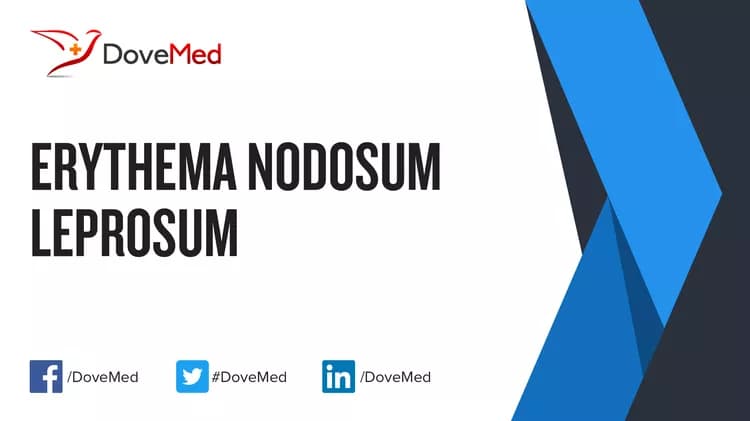What are the other Names for this Condition? (Also known as/Synonyms)
- Erythema Nodosum due to Leprosy
- Leprosy-Associated Erythema Nodosum
What is Erythema Nodosum Leprosum? (Definition/Background Information)
- Erythema Nodosum Leprosum is a skin condition that occurs in leprosy. It causes painful red subcutaneous nodules. Erythema nodosum is an inflammatory skin condition that is characterized by ‘tender-to-touch’ red bumps under the skin
- In general, erythema nodosum can have a variety of causes, such as the use of certain drugs and medications, infectious diseases, pregnancy, inflammatory bowel disease, blood cancer, and many other disorders
- Leprosy is a chronic infectious disease caused by the bacterium Mycobacterium leprae. Children are generally affected more than adults by leprosy
- The nodules in Erythema Nodosum Leprosum usually occur on the legs and the arms. The signs and symptoms of leprosy may include skin rashes, facial thickening, swollen lymph nodes, and joint pain
- Adequate treatment of the underlying infection can help resolve Erythema Nodosum Leprosum. With appropriate treatment of leprosy, the prognosis of erythema nodosum is good in a majority of individuals
Who gets Erythema Nodosum Leprosum? (Age and Sex Distribution)
- Erythema Nodosum Leprosum may occur at any age. However, generally children are more likely to be affected than adults by leprosy
- Both males and females are affected, although erythema nodosum is more often seen in females
- It can affect individuals of any ethnicity, race or region. However, most cases of leprosy are reported in the Indian subcontinent, Brazil, and parts of Africa
What are the Risk Factors for Erythema Nodosum Leprosum? (Predisposing Factors)
- Individuals with leprosy are at an increased risk for developing Erythema Nodosum Leprosum
It is important to note that having a risk factor does not mean that one will get the condition. A risk factor increases one’s chances of getting a condition compared to an individual without the risk factors. Some risk factors are more important than others.
Also, not having a risk factor does not mean that an individual will not get the condition. It is always important to discuss the effect of risk factors with your healthcare provider.
What are the Causes of Erythema Nodosum Leprosum? (Etiology)
- Research scientists believe that Erythema Nodosum Leprosum is caused by an immunological response to leprosy infection. The nodules form on skin as a reaction to underlying lepromatous leprosy
- Leprosy is caused by the bacteria Mycobacterium leprae. It is a contagious condition that spreads through infected respiratory droplets
What are the Signs and Symptoms of Erythema Nodosum Leprosum?
The signs and symptoms of Erythema Nodosum Leprosum may include:
- Erythema Nodosum Leprosum form as subcutaneous nodules that are painful
- There may be signs and symptoms of the associated leprosy, even before nodules appear beneath the skin
- This may include skin rashes, fever, fatigue, and joint pain
- The nodules may be present on any part of the body, especially on the legs, thighs, and buttocks
How is Erythema Nodosum Leprosum Diagnosed?
The following procedures may be used to diagnose Erythema Nodosum Leprosum:
- Thorough evaluation of the individual’s medical history and a complete physical examination
- Tests to diagnose leprosy that may include a tissue biopsy
- Tissue biopsy: A skin/tissue biopsy is performed and sent to a laboratory for a pathological examination. The pathologist examines the biopsy under a microscope. After putting together clinical findings, special studies on tissues (if needed) and with microscope findings, the pathologist arrives at a definitive diagnosis
- The tissue biopsy will reveal the presence of numerous leprosy-causing organism namely Mycobacterium leprae
Many clinical conditions may have similar signs and symptoms. Your healthcare provider may perform additional tests to rule out other clinical conditions to arrive at a definitive diagnosis.
What are the possible Complications of Erythema Nodosum Leprosum?
- Major complications associated with skin lesions of Erythema Nodosum Leprosum are not reported
- However, complications are mainly observed due to the underlying leprosy and may include physical disfigurement, loss of fingers/toes, and infertility
How is Erythema Nodosum Leprosum Treated?
The treatment options of Erythema Nodosum Leprosum include treating the underlying leprosy, which is undertaken through:
- Administration of antibiotics for a period of 6 months to 2 years
- Surgical restoration of disfigured body areas/limbs/digits
- Physiotherapy to help restore muscle function
On treating the underlying condition, in this discussion, leprosy, erythema nodosum usually disappears.
How can Erythema Nodosum Leprosum be Prevented?
The prevention of Erythema Nodosum Leprosum is linked to preventing leprosy, which may be enabled through the following measures:
- Avoiding close physical contact with untreated individuals with leprosy
- Undertaking early diagnosis and treatment of leprosy
- Community screening of high-risk groups
What is the Prognosis of Erythema Nodosum Leprosum? (Outcomes/Resolutions)
- The prognosis for Erythema Nodosum Leprosum is usually good with prompt treatment of leprosy
- However, the overall prognosis is also dependent on the underlying condition and the severity of the symptoms presented
Additional and Relevant Useful Information for Erythema Nodosum Leprosum:
- Cleaning the skin too hard with strong chemicals or soaps may aggravate the skin condition. Care must be taken avoid strong soaps and chemicals that could potentially worsen the condition
- The presence of dirt on the body is not a causative factor for the condition. However, it helps to be clean and hygienic, which may help the condition from getting worse
Related Articles
Test Your Knowledge
Asked by users
Related Centers
Related Specialties
Related Physicians
Related Procedures
Related Resources
Join DoveHubs
and connect with fellow professionals



0 Comments
Please log in to post a comment.